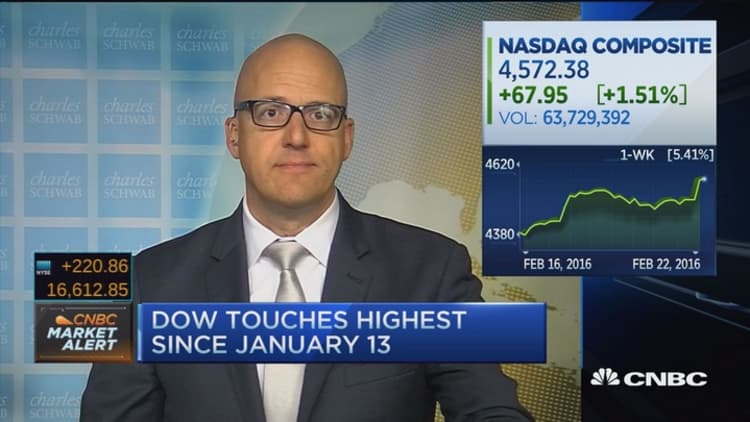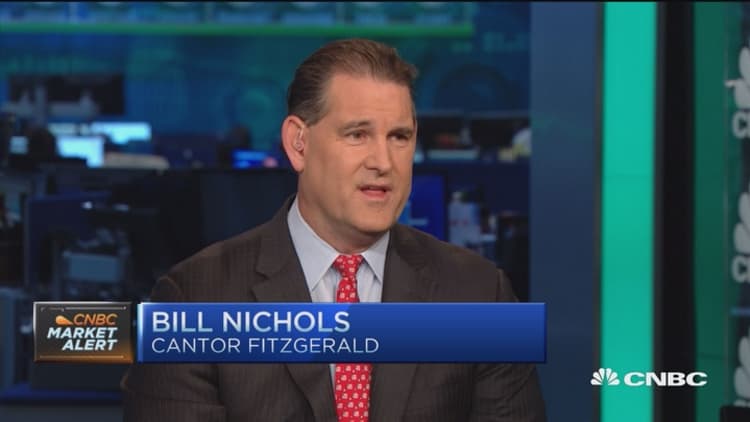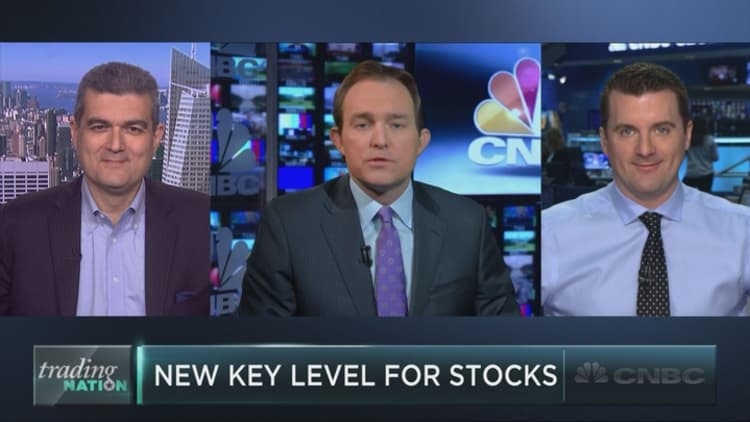


Don't be fooled by Monday's equity rally, we're not out of the woods yet, experts told CNBC.
Major U.S. stock markets rose 1.5 percent in early trading Monday. But that doesn't mean the down days are behind us, said Jeffrey Kleintop, senior vice president and chief global investment strategist at Charles Schwab.
"What we're in is not a trend to the downside — it's a trend towards greater volatility," Kleintop told CNBC's "Squawk on the Street."
What to watch
If the market isn't all clear, we're out of the woods "a little bit," Bill Nichols, head of U.S. equities at Cantor Fitzgerald, told CNBC's "Fast Money: Halftime Report" on Monday.
While lingering concerns like oil prices and a banking crisis will continue to weigh in the months ahead, there are a few key levels the pros are watching — and a few others they are taking with a grain of salt.
Nichols is looking for the yield on 10-year Treasury notes to hit 1.9 to 2 percent, he said, as well as a 1,965 to 1,970 level for the .
"You've seen real defensive plays, you know. Utilities and telecoms have been the leaders," Nichols said. "You're seeing a little bit of money coming out of that, I think, and seeing it rotate into the financials in a meaningful way. Right now you're just bouncing off the lows. You need another 5, 10, 15 percent rally from here to say, 'OK, here we go.'"
Michael Hanson, senior economist at Bank of America Merrill Lynch, is more focused on the stability of the U.S. economy. Hanson said he expects to see a rebound in U.S. first-quarter economic data, including durable goods orders and consumer spending, slated to be released this week.
"I do think that fear kind of trumped fundamentals for a bit there," Hanson told "Squawk on the Street" on Monday.
Read More This is the S&P level traders are talking about now
Eye with caution
Brexit — the exit of Britain from the EU — is another example of the concerns driving volatility in markets over the next few months, said Kleintop. But investors would be wise to ignore polls that try to predict the outcome of a British referedum, he said. While there are risks to the European Union or the U.S., Britain would bear the brunt of the costs of a Brexit, said Hanson.
U.S. oil also rose nearly 7 percent Monday after a projection that shale production would fall over the next two years, easing the supply glut that has driven prices lower.
"There's been a very high correlation between oil prices and what's happened with equities, and I think that is reflecting some concern that the drop in energy prices is the result of weak global demand," Hanson said. "But I don't think you really see it in the data."
A financial sector crisis is a third worry for markets, Kleintop said, pointing to rising credit default swaps for U.S. and European banks. But while markets dwell on banks' balance sheet issues, Kleintop said those are mostly isolated to earnings, and CDS levels are still lower than three years ago.
Indeed, look a couple years down the road and the financials are looking brighter, not like "something that's going to be a contagion and can pull down the global economy," Kleintop said.
"Make sure you have an appropriate, diversified asset allocation," Kleintop said. "This is not a time to go in overweight the stock market on the dips. This is a time to adhere to that long-term allocation."




